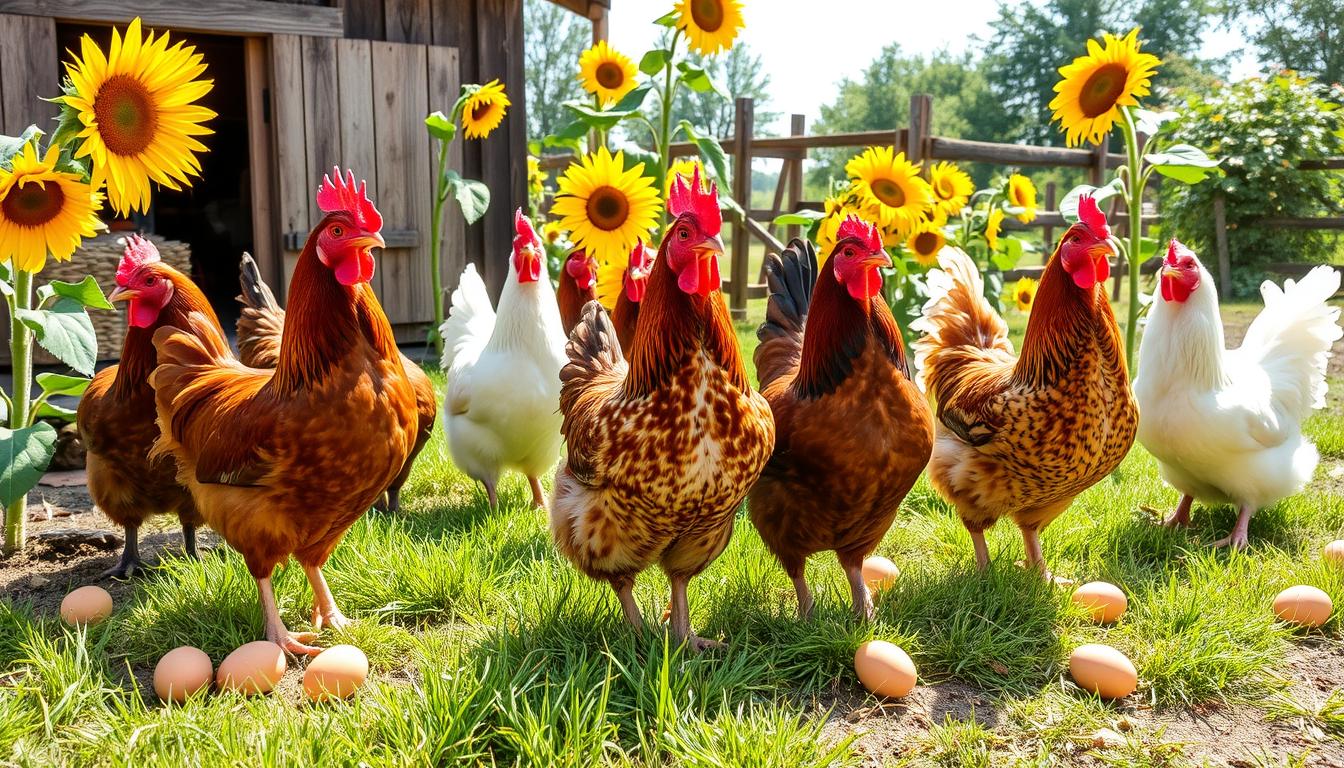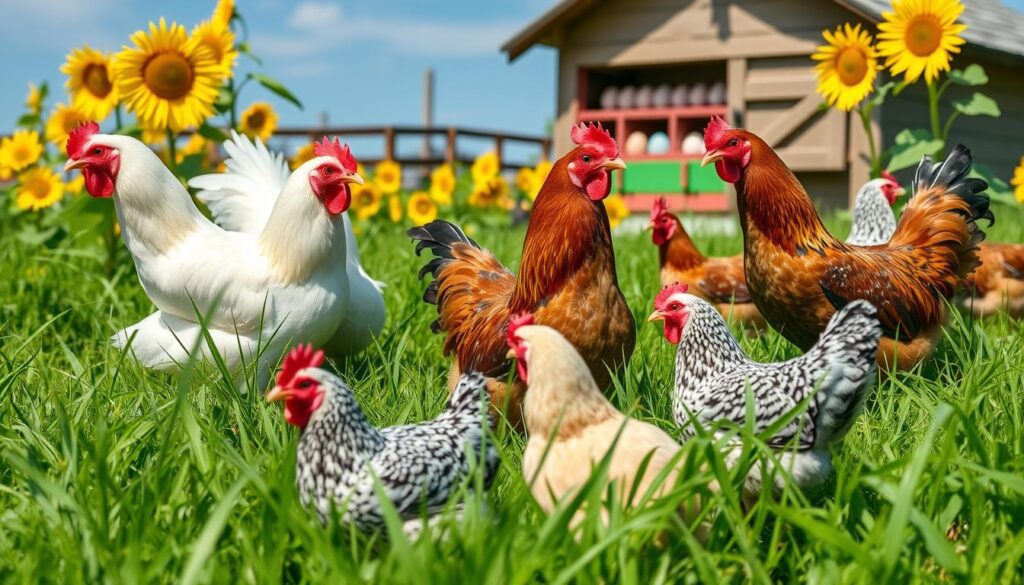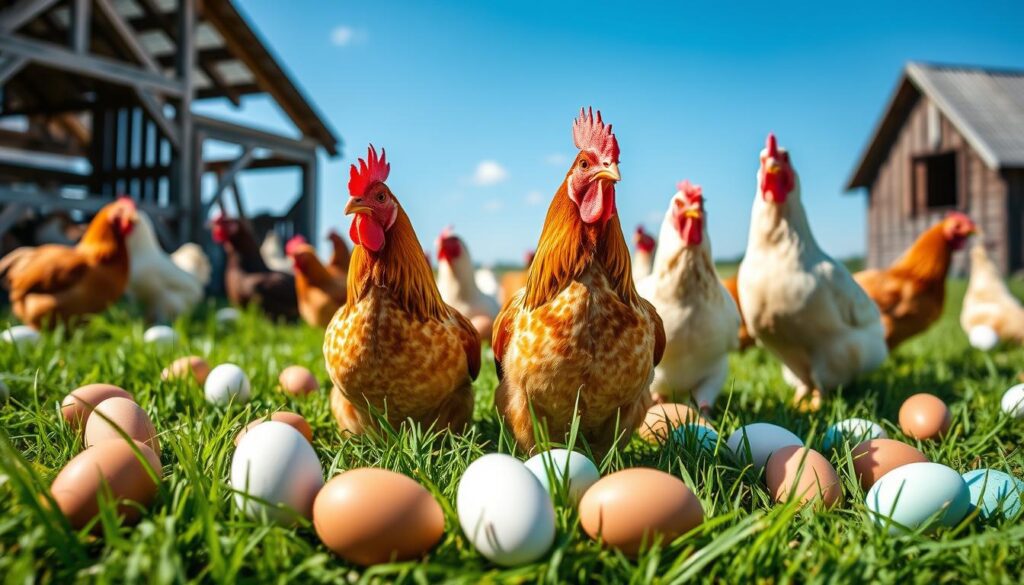Optimal Egg Layers: The Best Chickens for Fresh Eggs

Choosing the right chicken breed is key for getting lots of eggs. Leghorns can lay up to 280-320 eggs a year1. Rhode Island Reds lay around 200-300 eggs yearly2. These breeds are among the best for egg production in your backyard.
To learn more about the best chicken breeds for eggs, check out top egg-laying chicken breeds. You’ll find info on their egg-laying abilities and benefits.
Key Takeaways
- Choosing the right breed is important for egg production, like Leghorns or Rhode Island Reds.
- Top breeds like Leghorns, Rhode Island Reds, and Plymouth Rocks lay lots of eggs.
- Leghorns lay 280-320 eggs a year1, while Rhode Island Reds lay 200-300 eggs yearly2.
- Plymouth Rocks are good for both eggs and meat, laying 200-280 eggs annually2.
- Austra Whites lay 250-280 eggs a year2, and Golden Comet hens lay 250-300 eggs yearly2.
- ISA Browns lay up to 300 eggs a year2, and Lohmann Browns lay up to 300 eggs yearly2.
- Australorps lay over 300 eggs a year2, and White Leghorns lay over 300 eggs annually2.
Understanding Egg-Laying Chicken Breeds
Raising chickens for eggs means knowing the different breeds and their traits. You need to pick breeds that lay lots of eggs. Leghorns and Rhode Island Reds are great for this, laying many eggs3.
A good egg-laying hen should be healthy and eat well. The breed affects how many eggs a hen lays. For example, Isa Browns lay over 300 eggs a year, while Golden Comets lay 250-3004.
Things like food, health, and where they live affect egg laying. Chickens need a mix of grains, proteins, and vitamins. A clean, safe place to live also helps. Heritage chickens live longer and get sick less than hybrids4.
When picking a breed, think about egg laying, how friendly they are, and how much space they need. Australorps and Orpingtons are friendly and good with kids. But Leghorns and Rhode Island Reds lay more eggs but need more space3.
In short, knowing about chicken breeds is key to getting lots of eggs. Choose the right breed and give them good food and a safe home. Then, you’ll get fresh eggs from your backyard flock.
Best Chickens for Laying Eggs: Top Breeds Reviewed
Several breeds are known for laying lots of eggs. Leghorns can lay 280-320 eggs a year5. Rhode Island Reds lay 200-300 eggs annually5. Plymouth Rocks are good for beginners, laying about 200 eggs a year5.
Wyandottes lay 200-240 eggs a year6. Austra Whites produce 250-280 eggs yearly6. Minorcas lay large eggs, producing 200 or more eggs a year5. For more information, visit expert picks for egg-laying poultry.
Here’s a quick look at some top egg-laying breeds:
- Leghorn: 280-320 eggs per year5
- Rhode Island Red: 200-300 eggs per year5
- Plymouth Rock: 200 eggs per year5
- Wyandotte: 200-240 eggs per year6
- Austra White: 250-280 eggs per year6
These breeds are perfect for starting a flock of top-rated egg-layers for beginners. With the right care and food, they’ll give you fresh eggs for years.
Heritage vs. Hybrid Laying Breeds
Choosing the best chickens for laying eggs comes down to two main types: heritage breeds and hybrid layers. Heritage breeds are known for their unique traits and health benefits. They are less prone to disease and can lay eggs for a longer time7. Hybrid layers, on the other hand, are bred for high egg production. They can lay up to 300 eggs a year8.
Hybrid layers tend to lay more eggs, with some laying 21 eggs a week7. Heritage breeds, while not as prolific, can still lay around 200-250 eggs a year7. If you want lots of eggs, hybrid breeds might be the best choice. But if you value heritage traits, they’re a good option too.
Here are some key differences between heritage and hybrid breeds:
- Heritage breeds: known for their unique characteristics, longer productive lifespan, and disease resistance7
- Hybrid breeds: bred for high egg production, efficiency, and consistency8
The choice between heritage and hybrid breeds depends on what you need. If you want lots of eggs, hybrid breeds are a good pick. But if you value heritage traits, they’re a great choice too8.
Creating the Ideal Environment for Maximum Egg Production

To get the most from your chickens, create a perfect environment. This means a balanced diet, enough light, and a clean, safe home. The right food is key for egg-laying chickens. Hens start laying eggs at six months and can keep going for five to 10 years, laying most eggs in the first two years9.
High egg-layers like Rhode Island Reds and Wyandottes weigh about 6.5 pounds and lay brown eggs. They’re great for backyard eggs9. For best egg production, give them 12 to 14 hours of light a day. Also, keep their living area clean and safe, with at least 3 to 5 square feet per bird9.
Here are important things to think about for your chicken’s home:
* Give them a balanced diet with grains, proteins, and vitamins
* Make sure they get enough light, at least 12 to 14 hours a day
* Keep their home clean and safe, cleaning and disinfecting often
* Give them enough room, with at least 3 to 5 square feet per bird
By following these tips, you can help your chickens lay more eggs and stay healthy. Always research the specific needs of your chicken breeds. This way, you can give them the best care10.
| Breed | Weight | Egg Color |
|---|---|---|
| Rhode Island Red | 6.5 pounds | Brown |
| Wyandotte | 6.5 pounds | Brown |
| Ameraucana | 6 pounds | Green |
Essential Care Requirements for Laying Hens
Raising recommended chicken breeds for egg laying needs the right care for good egg production and health. This includes a balanced diet, health checks, and enough space. For example, chickens need 14-16 hours of light a day to lay eggs11.
For top laying hens for backyard flock, a balanced diet is key. Layer chickens need less protein but more calcium for strong eggshells12. The cheapest chicken feed costs $12-16 per bag13. Feeds with omega-3 fatty acids also help hen health and egg quality11.
Here are some key considerations for the care and well-being of your laying hens:
- Provide one nest box for every three hens to ensure comfort and privacy12
- Monitor health regularly to prevent stress and disease12
- Offer a balanced diet that includes calcium supplements, such as oyster shell, to support strong eggshells12
By following these essential care requirements, you can ensure your laying hens’ health and egg production. Choose recommended chicken breeds for egg laying and give them the right care for a successful backyard flock.
| Chicken Breed | Egg Production |
|---|---|
| Ameraucana | 150-200 light blue eggs per year13 |
| Australorp | 300 light brown eggs per year13 |
| Isa Brown | 300 large brown eggs per year13 |
Understanding Egg Color and Quality

When picking the best chickens for laying eggs, knowing about egg color and quality is key. Egg color changes with the chicken breed, with some laying white, brown, or blue eggs14. For more on eggshell color and egg quality, check out a guide to chicken egg colors.
Egg quality matters too. It includes shell strength, yolk color, and albumen quality. Some top egg-laying chicken breeds can lay up to 300 eggs a year, starting at 18-20 weeks15. To get the best eggs, keep your chickens happy with clean coops, good air, and enough room.
Here are important points for egg quality:
- Shell quality: A strong, clean shell keeps eggs fresh.
- Yolk color: A bright, yellow yolk means a healthy, tasty egg.
- Albumen quality: Clear, firm albumen shows a high-quality egg.
Understanding egg color and quality helps you choose the right chickens. Whether you want top egg-laying chicken breeds or just want to learn about egg production, there’s lots of info out there14.
Common Challenges in Egg Production
Raising productive egg-laying chickens comes with its own set of challenges. Experts say one big issue is not giving them enough good food. This can make them lay fewer eggs16. Chickens usually start laying eggs at 18–22 weeks old. Their egg production peaks at about 90% 6–8 weeks later16.
Several factors can affect how many eggs chickens lay. These include:
- Not enough energy, protein, or calcium in their diet
- Not enough salt, which can make them peck at feathers more and lay fewer eggs16
- Not enough calcium, which can make their egg production and eggshell quality worse16
Seasonal changes can also affect egg production. In Europe, more farmers are using non-cage systems. The number of laying hens in these systems has gone up from 8% in 1996 to 51% in 201917. Knowing these challenges and how to fix them can help keep your chickens healthy and productive.
Cost Considerations for Raising Laying Hens
When you decide to raise chickens for eggs, think about the costs. The initial setup can cost between $500 and $4,000. This includes the coop, feeders, waterers, and bedding18. Also, the price of chickens for egg-laying can be around $3-$5 per chick18. Don’t forget the monthly feed cost, which can be $20 to $50, depending on the brand and amount18.
A breakdown of the estimated costs is as follows:
- Coop: $100-$4,00019
- Predator proofing: $50-$10019
- Feeder and waterer: $50 each19
- Winter chicken supplies: $5019
- Brooder: $20-$4019
- Chicks: $2-$10 each19
When choosing chickens for eggs, remember these costs. They can affect your profit. But, with good planning, you can get fresh eggs while saving money.
Knowing the costs of raising laying hens helps you make smart choices. You can have a happy backyard flock. And get fresh eggs from your ideal chickens for fresh eggs.
Getting Started with Your Laying Flock
When picking your first chickens, look for top-rated egg-layers for beginners. Choose breeds known for laying lots of eggs and being easy to care for. ISA Browns, Orpingtons, and Easter Eggers are great for beginners20. They’re perfect for getting fresh eggs and are not too hard to take care of.
You’ll also need the right equipment to start. This includes feeders, waterers, and nesting boxes. Chicken feed costs about $20 for a 50-pound bag, with organic options a bit pricier21. Make sure your coop has enough space, with a minimum of 2 to 3 square feet per bird indoors and 8 to 10 square feet outside21.
For your coop, use pine shavings for bedding and Diatomaceous Earth for pests22. Don’t forget to add crushed eggshells and oyster shell supplements for better egg quality22. With proper care, you’ll see eggs from your flock in about 18-24 weeks20.
For more tips on starting your laying flock, check out pet care resources. They have great advice on raising healthy and happy chickens.
Maintaining Long-Term Laying Success
To keep your chickens laying eggs well, give them a balanced diet and watch their health. Experts say a diet of at least 90 percent complete layer feed is best for egg production23. Also, picking eggs up 2-3 times a day can lower the number of cracked eggs23.
It’s also key to give your chickens the right place to live. They need enough room, light, and air. For example, 16 hours of light a day can keep egg production strong23. You can find more tips on creating a great home for your chickens on pet care websites.
Some top egg-laying breeds are Australorp, Leghorn, and Novogen Brown chickens. They can lay up to 300 eggs a year in the best conditions24. By picking the right breed and following these tips, you’ll get plenty of fresh eggs from your backyard.
Here are some important things to remember for long-term laying success:
- Give them a balanced diet with at least 90 percent complete layer feed
- Pick eggs up 2-3 times a day to cut down on cracked eggs
- Make sure they have enough space, light, and air
- Pick a breed known for laying lots of eggs, like Australorp or Leghorn
By following these tips, you can keep your chickens laying eggs well. Always put their health first and get expert advice if you’re unsure25.
Conclusion: Making the Right Choice for Your Backyard Flock
Choosing the right chicken breed for your backyard is key. You should think about egg production, breed traits, and what you need2627. Breeds like Rhode Island Reds, White Leghorns, and Amber Stars lay lots of eggs26. Some can even lay up to 300 large eggs a year26.
Heritage breeds like Orpingtons and Chanteclers are also great. They keep laying eggs even when they’re older27.
The best breed for you will depend on your space, budget, and what you like27. By picking the right breed and caring for them well, you’ll get fresh eggs from your backyard2627.
FAQ
What are the top 3 best egg-laying chicken breeds?
What factors affect egg production in chickens?
What is the average egg production of a chicken per year?
What are the benefits of heritage breeds and hybrid layers for egg production?
What are the key factors in creating the ideal environment for maximum egg production?
What are the essential care requirements for laying hens?
How do egg color and quality affect the overall value of eggs?
What are the common challenges in egg production?
What are the cost considerations for raising laying hens?
What are the key factors to consider when getting started with a laying flock?
How can I maintain long-term laying success?
Source Links
- https://grubblyfarms.com/blogs/the-flyer/best-egg-laying-chicken-breeds?srsltid=AfmBOorsEZ0DVl1KDOTRhPNyBwyU2Nt5-ezY8NCRHX0oqHjXkeu-4Yfj – The 10 Best Egg Laying Chicken Breeds
- https://www.kalmbachfeeds.com/blogs/chickens/egg-laying-chicken-breeds-10-of-the-best-egg-laying-hens?srsltid=AfmBOorTIaaDldEqtJ49s2YnjC-b8CW91q3IZf-xotdK1jbkD5MDKUFa – Egg Laying Chicken Breeds: 10 of the Best Egg Laying Hens
- https://www.mannapro.com/homestead/bid/124918/The-Lowdown-on-Layers-Top-5-Laying-Chicken-Breeds-and-12-Tips – Top 5 Laying Chicken Breeds and 12 Tips
- https://grubblyfarms.com/blogs/the-flyer/best-egg-laying-chicken-breeds?srsltid=AfmBOooNvGOik_dJ4qhPvQ5uVAYzd4SbzCQ-qo_rF1PBqcm0IeD6EfLN – The 10 Best Egg Laying Chicken Breeds
- https://www.thehenhousecollection.com/blog/best-egg-laying-chickens/ – Best Egg Laying Chickens For Your Backyard | Get Eggs Fast!
- https://www.kalmbachfeeds.com/blogs/chickens/egg-laying-chicken-breeds-10-of-the-best-egg-laying-hens?srsltid=AfmBOoruhXZSgOJOxwLAYwgtSpHxz0sbJCNkJ2n9_5VkKkDz65lB5xTr – Egg Laying Chicken Breeds: 10 of the Best Egg Laying Hens
- https://cityboyhens.com/laying-eggs/hybrid-vs-heritage-breeds/ – Hybrid vs. Heritage Breed Chickens
- https://www.backyardchickens.com/threads/heritage-vs-hybrid.1598909/ – Heritage vs. Hybrid
- https://extension.umn.edu/small-scale-poultry/raising-chickens-eggs – Raising chickens for eggs
- https://starmilling.com/how-to-increase-egg-production/ – How to Increase Egg Production in Laying Hens | Star Milling Co.
- https://www.roobeez.com/blog/best-egg-laying-chickens-chicken-supplements-chicken-breeds – The Best Egg Laying Chickens, Best Chicken Supplements, and Top Chicken Breeds — Roobeez
- https://www.raising-happy-chickens.com/raising-chickens-for-eggs.html – Raising chickens for eggs: basic requirements
- https://www.theprairiehomestead.com/2020/03/raising-laying-hens.html – Beginner’s Guide to Raising Laying Hens • The Prairie Homestead
- https://grow.ifa.coop/chickens/best-egg-laying-chickens – The Best Egg Laying Chickens: A Guide to Egg Production | IFA’s Blog
- https://www.somerzby.com.au/blog/egg-laying-chickens/?srsltid=AfmBOopGKU-h8FpRX0t4lyrPf46x_EMm74O5HG4dRXpvEKbONzIdD_4g – Ultimate Guide to Egg Laying Chickens-Best Breeds & Colours
- https://edis.ifas.ufl.edu/publication/PS029 – PS-35/PS029: Factors Affecting Egg Production in Backyard Chicken Flocks
- https://layinghens.hendrix-genetics.com/en/news/what-are-challenges-facing-table-egg-industry-next-decades-and-what-can-be-done-address-them/ – What are the challenges facing the table egg industry?
- https://greenlight.com/learning-center/budgeting/how-much-do-chickens-cost – How much do chickens cost? Raising chickens for eggs
- https://fromscratchfarmstead.com/cost-of-chickens/ – Breaking Down The Cost Of Chickens For Eggs
- https://camrynrabideau.com/2024/03/27/the-best-chicken-breeds-for-beginners/ – The Best Chicken Breeds For Beginners
- https://earth911.com/home-garden/backyard-chickens-101-getting-started-with-laying-hens/ – Backyard Chickens 101: Getting Started With Laying Hens
- https://montanahomesteader.com/a-beginners-guide-to-raising-backyard-chickens-for-eggs/ – A Beginner’s Guide to Raising Backyard Chickens for Eggs
- https://www.purinamills.com/chicken-feed/education/detail/three-tips-to-help-backyard-chickens-lay-quality-eggs – Help Backyard Chickens Lay Quality Eggs| Purina Animal Nutrition
- https://homesteadingfamily.com/raising-backyard-egg-laying-chickens/ – Raising Backyard Egg Laying Chickens
- https://generationacresfarm.com/raising-chickens-for-eggs/ – Raising Chickens for Eggs | A Complete Guide To Raising Backyard Chickens
- https://www.artfulhomemaking.com/best-chickens-to-lay-eggs/ – What are the Best Chickens to Lay Eggs?
- https://grubblyfarms.com/blogs/the-flyer/choosing-the-right-chicken-breed-for-your-backyard?srsltid=AfmBOopnXtI76Aduwpb46o354kbPxSTmLFGaWxUmzjpQZngyBFP1ouy5 – Choosing the Right Chicken Breed for Your Backyard



